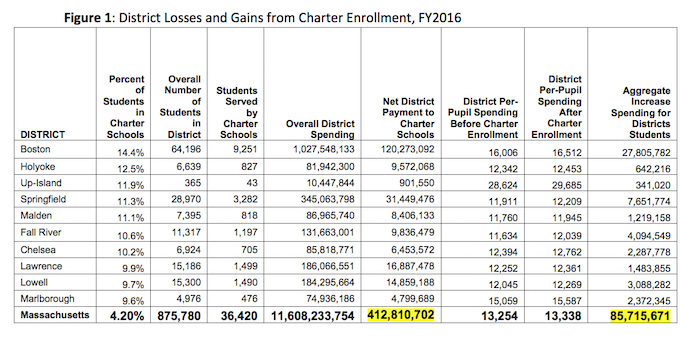On Nov. 8, Massachusetts residents will vote on Ballot Question 2, a referendum on whether to lift a statewide cap and allow up to 12 new charter schools to launch each year, with a preference given to charters that would open in low-performing districts. Proponents of lifting the cap argue that the Bay State’s charters are amongst the best in the nation. Opponents argue that whatever gains may accrue to charter students, the cost to the public school system is far too high.
 Perhaps because the research literature on the strength of Boston charter schools is so compelling, charter proponents have focused more on touting academic benefits than debating financial costs. This may have been a significant oversight, because while the claims of charter proponents have been borne out through gold-standard studies, the claims of charter opponents don’t stand up to a basic accounting analysis.
Perhaps because the research literature on the strength of Boston charter schools is so compelling, charter proponents have focused more on touting academic benefits than debating financial costs. This may have been a significant oversight, because while the claims of charter proponents have been borne out through gold-standard studies, the claims of charter opponents don’t stand up to a basic accounting analysis.
The Campaign to Save our Public Schools, a teachers’ union affiliated anti-charter advocacy organization, claims that charter enrollment costs traditional public school districts over $400 million dollars a year on net, largely from Chapter 70 state aid. While this figure isn’t false, focusing on it in isolation paints a significantly misrepresentative picture. Presenting net-cost alone misses two significant pieces to the financial puzzle: the per-pupil effect of charter enrollment on traditional districts, and the local funding contribution.
Chapter 70 Aid in a Nutshell
To understand MA charter finance, a basic understanding of the mechanics of the state funding system, Chapter 70, is necessary. Chapter 70 doesn’t fully fund Massachusetts schools through state funding, but rather is intended to make overall school finance more equitable across districts where property tax revenue varies. The state Chapter 70 contribution is based on a calculation made by the MA Department of Elementary and Secondary Education that sets a foundation budget based on the students residing in the district, weighted for their characteristics, and then calculates the necessary local finance contribution based on aggregate property values and income. Whatever portion of the foundation budget is not covered by the local contribution is then covered by Chapter 70 foundation aid.
Districts then “pay” charter schools an amount consistent with the per-pupil cost of education each student in a district school. Districts are reimbursed through another funding stream for students who have left traditional district schools for charters: 100 percent of per-pupil in the first year, 25 percent for the next five years, as well as an annual per-pupil facilities cost of approximately $900 dollars. Although the state has not always fully funded the reimbursement stream, it is the most generous in the nation.
Net Losses vs. Per-Pupil Gains
The effect is that district schools receive a significant sum of money for students that they no longer teach. As a result, even as net district school funding decreases due to charter enrollment, total per-pupil funding effectively increases. To illustrate the effect, consider the table below. The data are pulled from the Massachusetts Teachers Association website in their calculations of statewide net losses to district schools for 2016. By extending the data to calculate the net per-pupil financial effect of charter enrollment on district schools, we see that even as charter enrollment presents a net cost of $412 million to traditional districts, it also effectively causes an increase of $85 million dollars in aggregate spending for district students.

Now, one can’t conclude that the aggregate per-pupil spending increase necessarily presents a net-benefit to traditional district schools. District administrators may be quick to point out that due to longstanding vendor agreements, work rules, and bargaining arrangements, the net cost might be operationally more consequential than the per-pupil gains. But at the very least, the financial equation is far more complex than charter opponents have let on.
Local Contribution: Spotlight on Boston Public Schools
In fact, in Boston charter enrollment does not even present a net cost to the school district. As the Boston Municipal Research Bureau has pointed out, even though Boston has seen its net Chapter 70 aid decrease by $56 million dollars from FY2011 to FY2015, in large part due to increased charter enrollment, its overall operating budget has increased by 23.4 percent.
This paradox can be explained quite simply: state aid pays for nearly all charter tuition costs, while the local government covers the differential and then some. “While the growth in charter schools does have a direct correlation to appropriations to the in-district system in some districts, this has not been the case in Boston,” explains the Boston Municipal Research Bureau. “The City has continued to support the BPS despite growing charter school assessments. The true cost of charter expansion has not been a matter of revenue, but rather the struggle of eliminating excess capacity and rightsizing an urban school district.”
That is an important concern, and increases in charter enrollment would contribute to those difficulties. If traditional districts had the administrative flexibility of charter schools, then increased charter enrollment would present a clearer win-win. As it stands, it presents a mixed proposition, but certainly not the dire, massive drain that charter opponents claim.
Thus far the terms of the charter cap debate have been set as altruism vs. self-interest. As the mixed polling currently shows, appeals to self-interest can often win out against appeals to social justice. Thus far, charter advocates have ceded ground unnecessarily. The notion that charter enrollment presents a net cost of over $400 million to districts is incomplete and misleading; just as strong a claim could be leveled that charter enrollment provides districts with an aggregate $85 million spending boost for their students.
—Max Eden
Max Eden is a Senior Fellow at the Manhattan Institute and the author of the recent report, “Lifting the Massachusetts Cap on Charter Schools: Pro and Con.”


